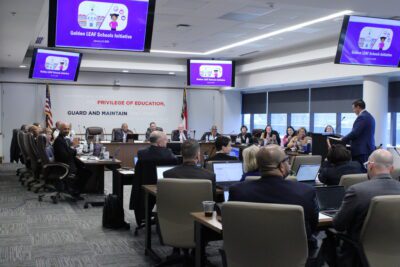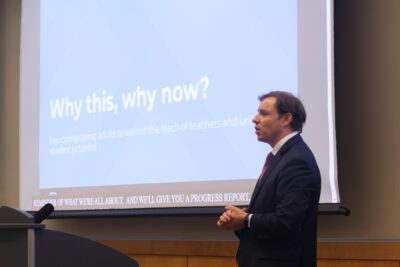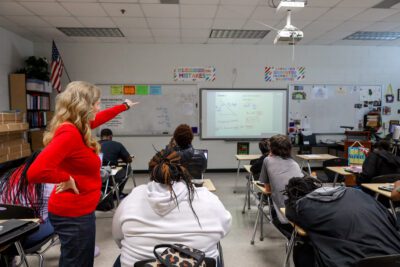
Math scores nationwide have not yet returned to pre-pandemic levels. Among some students, those metrics are still dropping. However, states are stepping up to reverse those trends, coalescing around targeted interventions for low-performing students, screeners and assessments, professional development, and legislation directed at math achievement.
The Education Commission of the States (ECS) presented these findings in an Aug. 26 webinar on the approaches different states are using to improve K-12 math achievement, including a highlight of Union County Public School’s high-dosage math tutoring model.
![]() Sign up for the EdDaily to start each weekday with the top education news.
Sign up for the EdDaily to start each weekday with the top education news.
NAEP results — sometimes called the nation’s report card — showed concerning trends in math scores last year. Nationally, fourth graders saw a score decline of three points in 2024 and eighth graders dropped eight points compared to 2019. The majority of states showed no significant changes in their math scores compared to 2022.
Still, states have made some progress since 2019. In 15 states — including North Carolina — fourth graders scored higher in math 2024 than in 2022. Nationwide, the percentage of students at or above “Basic” — the lowest achievement level on the NAEP — increased by 2 points.
“We’ve seen lots of momentum in the states to take steps to improve instruction,” Adrienne Fischer, a senior policy analyst at ECS, said during the webinar.
Screeners or assessments to identify students requiring additional support have become requisites in some states, Fischer said. States are also creating policies to ensure that those students receive interventions to get back on track, including personalized learning plans, tutoring, or summer learning programs.
Access to high-quality instructional materials and evidence-based curricula, as well as professional development for math instructors have also been priorities for some states seeking to improve their math scores.
The approaches have mimicked those used to address literacy in recent years, Fischer said.
“Obviously, math and literacy are very different in how the learning progression occurs with foundational concepts building upon each other in order to scaffold into more complex math and later grades,” she said. “But the basic policy approaches of assessment, intervention, and teacher preparation are being employed in similar ways in a growing number of states.”
The ECS also identified at least 14 states with legislation related to math instruction.
In North Carolina, for example, Rep. David Willis, R-Union, introduced House Bill 875 in April, directing the Department of Public Instruction (DPI) to provide a system of “high quality” math instruction and support to public schools, and then report on what those supports are. The bill was referred to the committee on rules and operations of the Senate in early May.
Another North Carolina effort to address math scores is the Golden LEAF Schools initiative — a five-year $25 million program that aims to improve 15 rural middle schools’ performance with a focus on mathematics and career development.
Related reads


Learning progressions
Dr. Gene Kerns, chief academic officer at software company Renaissance, discussed the company’s math work on “learning progressions” — the sequence of ideas students must move through to learn a concept.
Kerns said teachers often know their own grade well but lack a clear picture of what comes before and after their grade. Instead, he argued, teachers should take a 50-50 approach, focusing equally on their own grade and contextualizing that information with lessons taught in other grades.
As part of that work, Renaissance analyzed every state’s math standards and reordered them into what Kerns called an “ideally teachable” sequence. From that analysis, the company identified a subset of “focus skills” for each grade — the building blocks that most strongly prepare students for the next year.
Across states, roughly 28% of standards fell into this category. Kerns said that teachers still cover all standards, but understanding which skills are foundational helps them prioritize time and plan more targeted instruction.
He said learning progressions also make assessments more useful. When tests are designed around the steps students typically take, the resulting data better signals “what’s next” for instruction.
“When we understand the steps of learning along the way and we create an assessment, the data from that assessment then does an even better job at informing us about what the next step for a student might be,” Kerns said.
High-dosage math tutoring
The webinar featured a presentation from Union County Public Schools Superintendent Dr. Andrew Houlihan, who highlighted the district’s high-dosage math tutoring model.
Under the model, the district’s fourth and seventh graders receive daily 30-minute math tutoring sessions in small groups — four students or fewer per tutor — outside their regular classroom.
The district created its own data-driven curriculum, featuring prescriptive lessons that are two days behind the original lesson. Tutors are non-certified personnel with high school diplomas who must pass a math assessment, undergo robust onboarding, and receive monthly training. Each school must have a tutoring “champion” responsible for spearheading the initiative and providing a designated space for tutoring in their building.
In 2017, the district began the model to support persistently low-performing schools. That school year, the percentage of fourth graders proficient in math in participating schools increased by 12.4 percentage points compared to the prior school year, Houlihan said. By the end of the 2018-19 school year, four out of the district’s six elementary schools deemed low-performing exited that status.
Among seventh graders in participating middle schools, the percentage of students proficient in math jumped by 26.1 percentage points between 2016-17 and 2018-19, he said.
From 2020 to 2024, the district expanded the model to additional schools.
“While our accountability scores have yet to be released publicly, what I will say is we are confident that if we were to add a bar graph or a chart for 24–25 reflecting last year’s math performance in both fourth and seventh grade, you’re going to see those go up even more,” Houlihan said ahead of the Sept. 3 release of the latest school performance grades.
A May 2025 study by the Education Policy Initiative at Carolina found that the whole-grade tutoring model in Union County was “positive and robust,” with better results than targeted tutoring models. The program was also cost-effective relative to other programs, with annual costs per student ranging from $750 to $2,500.
Math legislation
Micki Ray-Marinelli, chief academic officer for the Kentucky Department of Education (KDE), spoke about the state’s 2024 Numeracy Counts Act, which aims to improve student outcomes in mathematics.
Under the law, every district superintendent must select a K–3 universal math screener from a KDE-approved list and administer the screener beginning in the 2026-27 school year. KDE must also create a K-3 multi-tiered system of support in mathematics and provide technical assistance to districts.
“They shared earlier that there were 15 states who did see growth between 2022 and 2024 on those NAEP results, and I’m happy to say that Kentucky was one of those states,” Ray-Marinelli said. “But we have much work to do, and I don’t think any of us across the Commonwealth would say that there is not further improvement because behind the data are students, and we want students to achieve proficiency in mathematics.”
You can watch the full webinar on ECS’ YouTube channel.
Recommended reading



